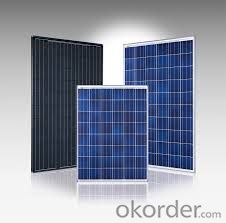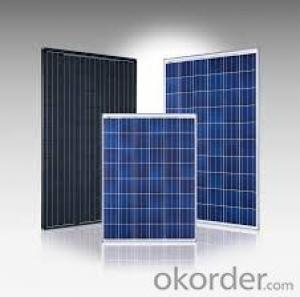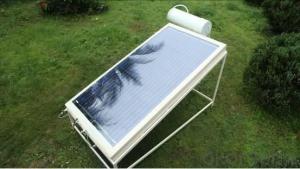Factory Directly Sale Polycrystalline solar Panel CNBM
- Loading Port:
- Qingdao
- Payment Terms:
- TT OR LC
- Min Order Qty:
- 10 set
- Supply Capability:
- 300000 set/month
OKorder Service Pledge
OKorder Financial Service
You Might Also Like
Polycrystalline Solar Modules
CNBM offers a range of small, medium and large polycrystalline solar modules, designed for a range of requirements.


Specifications:
Tolerance | +/-3% |
Cell | Polycrystalline silicon solar cells (156 x 156mm) |
N0. of Cells | 60 (10 x 6) |
Dimension of Modules (mm) | 1650 x 990 x 40 |
Weight (kg) | 25.5 |
Limits:
Operating Temperature | -40~+85? |
Storage Temperature | -40~+85? |
Maximum System Voltage | 1000 VDC max. |
Hail Impact | Diameter of 28mm with impact speed |
Temperature and Coefficients:
NOCT | 48C+/-2? |
Voltage temperature coefficient (%/K) | -0.35 |
Current temperature coefficient (%/K) | 0.05 |
Power temperature coefficient (%/K) | -0.45 |
Characteristics:
Model: | SGM-200P | SGM-210P | SGM-220P |
Max-power voltage Vmp (V) | 29.2 | 29.4 | 29.41 |
Max-power current Imp (A) | 6.85 | 7.14 | 7.48 |
Open-circuit voltage Voc (V) | 36.5 | 36.69 | 36.9 |
Short-Circuit Current Isc (A) | 7.28 | 7.6 | 7.93 |
Max-power Pm(W) | 200 | 210 | 220 |
Model: | SGM-230P |
Max-power voltage Vmp (V) | 29.8 |
Max-power current Imp (A) | 7.72 |
Open-circuit voltage Voc (V) | 37.31 |
Short-Circuit Current Isc (A) | 8.19 |
Max-power Pm(W) | 230 |
STC: Irradiance 1000W/m2, module temperature 25?, AM-=1.5
Poly Crystalline Solar Panels Specifications Range
Maximum Power (Pm) | Dimension | Weight | Operating Voltage (Vmp) | Operating Current (Imp) | Open Circuit Voltage (Voc) | Short Circuit Current (Isc) |
0.45W | 140x80x10mm | 0.08kg | 3.3V | 150mA | 4.6V | 160mA |
1.0W | 162x140x10mm | 0.16kg | 7.5V | 150mA | 10.3V | 160mA |
4.5W | 269x251x23mm | 0.8kg | 16.5V | 0.27A | 20.5V | 0.3A |
10W | 420.1×268.9×22.6mm | 1.92kg | 17.5V | 0.58A | 20.5V | 0.6A |
20W | 425x502x50mm | 3.0kg | 16.8V | 1.19A | 21.0V | 1.29A |
30W | 593x502x22.6mm | 3.9kg | 16.8V | 1.78A | 21.0V | 1.94A |
40W | 655x537x50mm | 5.75kg | 17.3V | 2.31A | 22.1V | 2.54A |
50W | 839x537x50mm | 6.0kg | 17.5V | 2.9A | 21.8V | 3.17A |
65W | 1111x502x50mm | 7.2kg | 17.6V | 3.69A | 22.1V | 3.99A |
80W | 1204x537x50mm | 7.7kg | 17.6V | 4.55A | 22.1V | 4.8A |
- Q:Is silicon-based solar cells and silicon-based thin-film solar cells the same?
- General silicon-based solar cells refer to monocrystalline silicon and polycrystalline silicon solar cells, while silicon-based thin-film solar cells are similar to sunpower producing that type of battery that can be made into curved components.
- Q:What is the impact of solar cells on reducing dependence on foreign energy sources?
- Solar cells have a significant impact on reducing dependence on foreign energy sources by providing a renewable and locally available source of electricity. By harnessing the power of the sun, solar cells offer a clean and sustainable alternative to fossil fuels, which often need to be imported from other countries. This shift towards solar energy not only enhances energy security but also reduces reliance on foreign nations for energy supply, thus promoting self-sufficiency and reducing geopolitical risks associated with energy imports.
- Q:Can solar cells be used in remote locations?
- Yes, solar cells can be used in remote locations. They are an ideal solution for providing electricity to areas that are off the grid or have limited access to traditional power sources. Solar cells can be set up in remote locations to harness the energy from the sun and convert it into electricity, making them a reliable and sustainable option for powering remote areas.
- Q:What diode does the solar panel use?
- The main difference between the two diodes in the application of solar energy is the conduction voltage drop, the Schottky 0.4V or so, the ordinary 0.7V or so, mainly depends on your solar cell output voltage, if the solar cell voltage is lower than 5V or even 2V
- Q:Can solar cells be used for powering communication systems?
- Yes, solar cells can be used to power communication systems. Solar cells convert sunlight into electrical energy, which can then be used to power various electronic devices, including communication systems. This renewable source of energy is a sustainable and environmentally friendly option for powering communication systems, especially in remote or off-grid locations where access to traditional power sources may be limited.
- Q:Can solar cells be used for powering mining operations?
- Yes, solar cells can be used for powering mining operations. Solar energy can be harnessed through photovoltaic cells, which convert sunlight into electricity. By installing solar panels, mining operations can reduce their dependence on fossil fuels and lower their carbon footprint. Solar power can be used to run equipment, lighting, and other electrical systems required for mining operations. Additionally, solar energy can be stored in batteries for use during non-sunlight hours, ensuring a continuous power supply.
- Q:How are solar cells connected in a solar panel?
- Solar cells are connected in a solar panel through a series of electrical connections called interconnects. These interconnects form a circuit that allows the flow of electrons between the individual solar cells, ensuring that the electrical current generated by each cell is combined to produce a higher voltage and power output.
- Q:How do solar cells perform in areas with frequent thunderstorms?
- Solar cells can still perform efficiently in areas with frequent thunderstorms, although their performance may be affected during periods of heavy cloud cover or rainfall. Thunderstorms can temporarily reduce sunlight exposure, leading to a decrease in solar cell output. However, solar cells are designed to withstand various weather conditions, and their performance can quickly recover once the storms pass. Additionally, advancements in solar technology, such as the use of anti-reflective coatings and improved cell designs, help to enhance performance even in less ideal weather conditions.
- Q:Can the 156x156mm high efficiency single crystal cells assembly function better compared to the traditional one?
- The media already commented a lot on the 156x156mm high efficiency single crystal cells assembly, which make me wonderabout its real function.
- Q:Can solar cells be used to power surveillance cameras?
- Yes, solar cells can be used to power surveillance cameras. Solar cells, also known as photovoltaic cells, convert sunlight into electricity. By installing solar panels and connecting them to surveillance cameras, the cameras can be powered by the generated solar energy, making them independent of traditional power sources. This allows for remote surveillance in areas without access to the electrical grid, increasing flexibility and reducing costs in surveillance systems.
1. Manufacturer Overview |
|
|---|---|
| Location | |
| Year Established | |
| Annual Output Value | |
| Main Markets | |
| Company Certifications | |
2. Manufacturer Certificates |
|
|---|---|
| a) Certification Name | |
| Range | |
| Reference | |
| Validity Period | |
3. Manufacturer Capability |
|
|---|---|
| a)Trade Capacity | |
| Nearest Port | |
| Export Percentage | |
| No.of Employees in Trade Department | |
| Language Spoken: | |
| b)Factory Information | |
| Factory Size: | |
| No. of Production Lines | |
| Contract Manufacturing | |
| Product Price Range | |
Send your message to us
Factory Directly Sale Polycrystalline solar Panel CNBM
- Loading Port:
- Qingdao
- Payment Terms:
- TT OR LC
- Min Order Qty:
- 10 set
- Supply Capability:
- 300000 set/month
OKorder Service Pledge
OKorder Financial Service
Similar products
New products
Hot products
Hot Searches
Related keywords





























